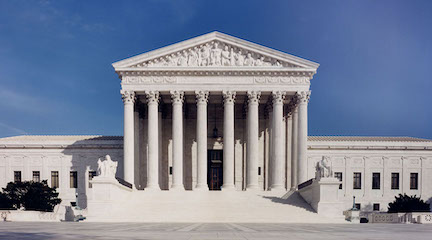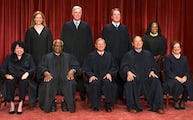 |
A Vacancy on the Court | < |
The NomineesQualificationsThe American Bar Association asserts that a justice should possess the highest standards of integrity, professional competence, and judicial temperament. It's hard to disagree with that, but what makes politics so interesting is the different spin that can be given to common terms. Click on an individual term to explore it a bit further. Consistent with these qualifications, however, there are other motivations driving presidential nominations of justices. Presidents want justices who will vote to decide cases in a manner consistent with the president's own ideological perspectives. To do otherwise, in the words of George Washington, would be "a sort of political suicide." However, the desire to appoint a qualified person presumably sympathetic to his own ideological leanings does little to narrow the field of potentially acceptable nominees. The history of Supreme Court appointments reveals at least five other motivations that drive presidential appointments: rewarding personal or political support; representing certain interests; cultivating political support; ensuring a safe nominee; picking the most qualified nominee. ControversyIt is hard to understand why your nomination would generate controversy. The answer is found in one word, . . . and that word is "politics." Senator Orrin Hatch to Robert Bork during the latter's confirmation hearings. Senator Hatch is correct, of course, but it is also important to realize that he too was deeply engaged in politics even as he spoke that sentence. All Supreme Court nominations are political. The process was designed that way by the framers, who themselves could not agree on an appointment process. Appointment by the president and approval by the Senate was a political compromise and assured the procedure would be a political one. Political is not the same as controversial, however. Some presidents, and Clinton was one, opt for the politics of consensus when it comes to Supreme Court nominations. Much political consideration is given to selecting someone who will not generate opposition. Controversy requires opposition, which also assumes that there is support as well. Without disagreeing sides, there is no controversy. In addition, the opposition must be more than token. There must be some intensity, some contentiousness, without which controversy will fail to maintain itself or even materialize. Ultimately, for controversy to gain much play in the media, there must be sufficient opposition to the nomination to raise at least some potential for defeating the nominee. For more about controversy and some specific examples, see Shaping America; The Politics of Supreme Court Appointments by George Watson and John Stookey, beginning at page 14 and again at page 122, but really throughout the entire book. For interesting quotes on nominees over the ages, see [Reactions to Nominees.] Potential NomineesPresident Clinton's approach seems to have been to float "publicly" a number of names of potential nominees to gather reactions. If that wasn't intentional, he was still been captured by it. It seems evident that his ultimate selections have been based in part on the reactions that came forward. For example, political opposition to Bruce Babbitt's nomination apparently caused the president to shy away from considering him further. In this manner, Clinton often flirted with naming someone not currently a federal judge. From the world of politics came the names of Babbitt, George Mitchell, and Mario Cuomo. In the final analysis, Clinton sought more the politics of consensus than the politics of confrontation and controversy. As part of that strategy, he ultimatlely with veteran judges. Both Ginsburg and Breyer had 14 years on the bench before their appointments. President Bush has been more willing to be confrontational in his appointments to the federal bench, sticking with a number of nominees who were subject to delaying tactics by the opposition regarding confirmation. Bush won out, however, in a showdown between the Senate Republican majority, which threatened a rule change to eliminate minority filibusters on judicial nominations, and the Democrats, who acquiesced in permitting votes on certain nominees to come to the Senate floor in exchange for keeping the right to filibuster, something that could become a reality in a key Supreme Court nomination. With John Roberts, President Bush put forward a young (50) and well-respected attorney with two years experience on the D.C. Circuit Court who would appear to satisfy the president's conservative judicial sentinels without evoking the wrath of the liberal judicial watch. Of course, close scrutiny of the nominee is yet to come, but the president's strategists seemed to be aiming for a justice who would be more consistently conservative across a range of issues than Justice O'Connor, but with legal and intellectual credentials and a judicial temperament that would make him difficult to oppose. However, when the Chief Justice position came open, the quick move to fill that position with Roberts meant that little change seemed to be in the works in terms of Court decisions based on a Roberts for Rehnquist replacement. If anything, there may be some concern among conservatives that Roberts will not walk in the full range of Rehnquist steps. The initial strategy for filling the O'Connor vacancy was abandoned with the nomination of White House counsel Harriett Miers. President Bush may well have still been aiming for a justice who would be more consistently conservative than O'Connor, but in nominating someone with no public record, statements, or experience regarding a very wide range of constitutional issues, Miers was not one who would be difficult to oppose. The opposition from the more conservative of Republicans was immediate and persistent. The president could only offer personal assurances regarding her suitability, a strategy that in itself raised red flags among the Democrats without mollifying the opposition within his own party. Updated by George Watson on October 27, 2005. |